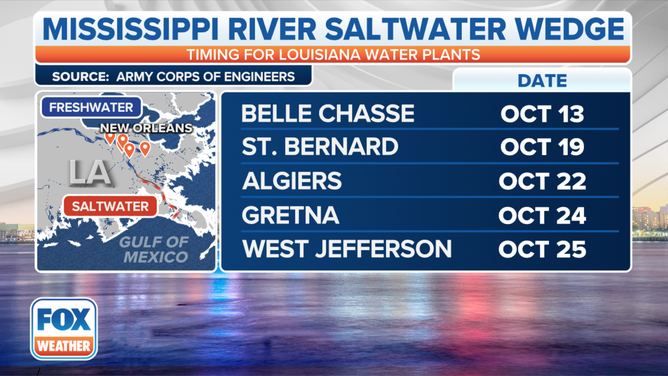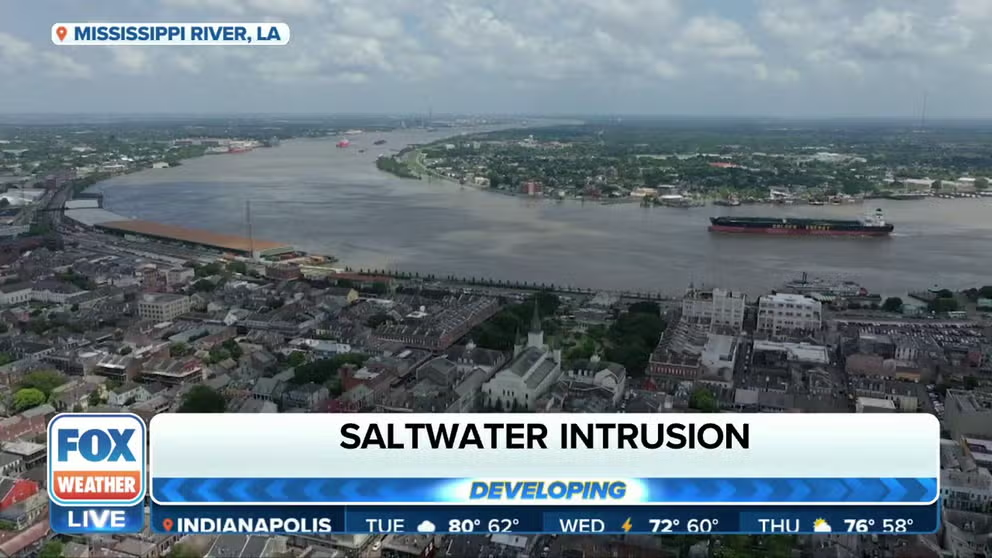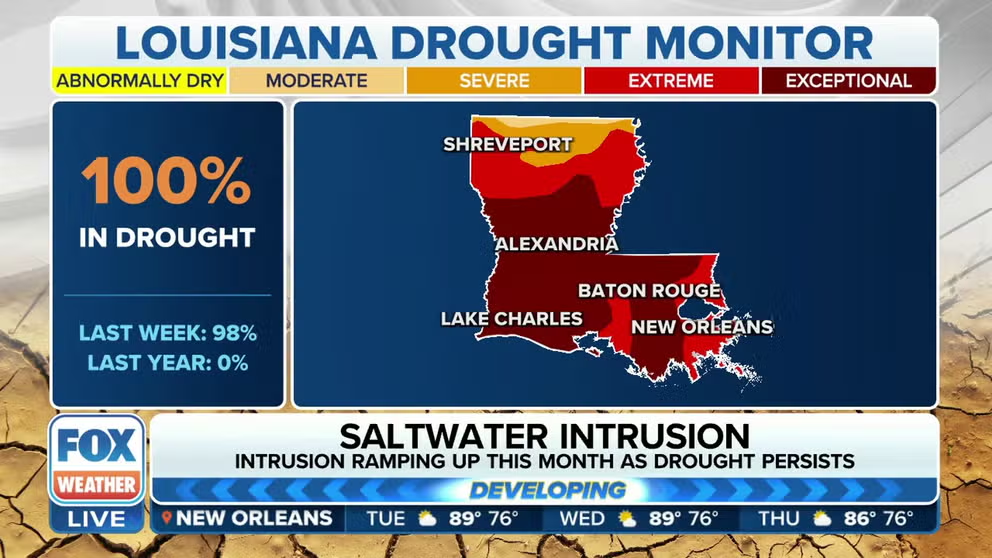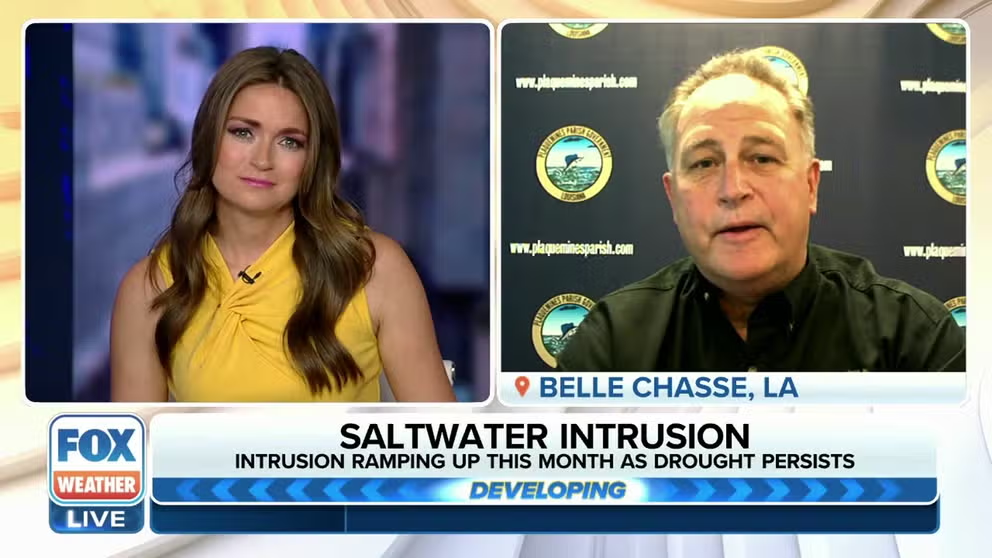Biden approves Louisiana emergency as Mississippi River saltwater intrusion threatens drinking water
The federal emergency declaration provides funding for the ongoing response and mitigation efforts as well as FEMA assistance.
New Orleans to see drinking water impacts from saltwater intrusion
Without enough fresh water in the Mississippi River salt water from the Gulf of Mexico is intruding on Louisiana's fresh drinking water supply. FOX Weather Correspondent Robert Ray reports from New Orleans, where the drought continues.
NEW ORLEANS – As the Mississippi River is forecast to hit record lows during the current extreme drought, impacting the drinking water in southeast Louisiana, President Joe Biden approved a federal emergency declaration after a request from Louisiana Gov. John Bel Edwards for federal assistance.
Low levels in the lower Mississippi River allow salt water from the Gulf of Mexico to intrude farther up the river, impacting local water treatment centers. While Plaquemines Parish is the only parish under a drinking water emergency, the situation is expected to worsen, eventually impacting drinking water in New Orleans and surrounding parishes.
On Tuesday, Biden approved Edwards' request for help to address the saltwater intrusion. The declaration provides funding for the ongoing response and mitigation efforts and assistance from other federal partners, including the Federal Emergency Management Agency and Homeland Security.
"I want to thank everyone at the state and local level who have been leading this fight, along with our partners at the Army Corps of Engineers," Edwards said. "We have had discussions with FEMA about the unique challenges we face with this event. We are optimistic the president will approve our federal emergency declaration, which will be crucial to help our communities along the lower Mississippi River."
Without enough freshwater flow, seawater is making its way up the river and is expected to reach St. Bernard, Jefferson and Orleans Parish in mid-October. The U.S. Army Corps of Engineers New Orleans District is attempting to hold off the salt water by elevating a sill on the river bottom an additional 25 feet, which is expected to be complete in two weeks.
How does the drought in the Midwest impact the drinking water in New Orleans?
This is the second year in a row that drought conditions in the river have created this problem, according to Lower Mississippi River Forecast Center hydrologist Jeff Graschel. While more than 90% of Louisiana is under extreme to exceptional drought, the problem with the river stems from drought in the Midwest.
Dangerous saltwater intrusion continues in lower Mississippi River amid drought
Lower Mississippi River Forecast Center hydrologist Jeff Graschel explains that rains have not made it far enough west to help with the extreme drought conditions in the Mississippi River. As the drought continues, salt water is making its way into the lower Mississippi and threatening the drinking water supply in Louisiana.
"What happens is if we don't get a lot of rainfall in the upper parts of the Midwest … that's really where all the flow comes from," Graschel said. "By the time the Ohio and the Mississippi Rivers come together, that's about 90% of the water that comes down to part of the lower part of the Mississippi River near New Orleans."
Without the needed rainfall by September, there isn't enough flow from the Mississippi River to hold off the Gulf of Mexico.
"The salt water wants to move in, and the power of the river keeps it back. We need 300,000 cubic feet per second to push the saltwater back into the Gulf. Right now, we have 150,000, so we have half of what we need," U.S. Army Corps of Engineers New Orleans District Public Affairs Chief Ricky Boyett said.
Graschel said all the rain from the East Coast, including from multiple tropical systems, has not made it far enough west to help with the extreme drought conditions in the Mississippi River.
"It's been very dry over the middle portions of the United States where a lot of the water comes from in the New Orleans area," Graschel said. "So all that rain you're describing on the East Coast and stuff hasn't made its way westward to get into the Ohio Valley to allow us to really have more of higher levels on the rivers in the lower part of the Mississippi."
This situation does occur, but usually, about every 10 years and the U.S. Army Corps of Engineers will put a low-water sill on the bottom of the river to impede the salt water from moving upstream.
"It's extremely unusual to have it two years in a row that they have to build that sill to protect the New Orleans area from the salt water," Graschel said.
U.S. Army Corps of Engineers working to buy time against salt water moving up Mississippi River
Ricky Boyett, with the U.S. Army Corps of Engineers, explains how raising a sill, or underwater levee, will buy time to hold off salt water intruding on the lower Mississippi River. Salt water from the Gulf of Mexico is threatening drinking water in Louisiana because of the low water levels in the river.
On Monday, U.S. Army Corps of Engineer teams began to raise the sill, an underwater levee, in an attempt to hold off the salt water. However, it's not a permanent solution to the intrusion. Boyett said the only real solution is rain.
"It will buy time so that the local parishes in the state, as well as the federal government, have opportunities to get other measures in place," Boyett said.
In the immediate future, the Lower Mississippi River Forecast Center does not see conditions improving. Significant rain in the Midwest would be needed to help the flow in the lower Mississippi River. Even with rainfall, it takes time to reach the lower Mississippi.
Seawater reaches Plaquemines Parish water treatment facility on West Bank of Mississippi
A State of Emergency has been in place for Plaquemines Parish since July due to the saltwater impacts on the Venice-Boothville drinking water system.
Plaquemines Parish President Keith Hinkley said the community has dealt with these impacts since mid-June.
Plaquemines Parish President: No need to panic as Mississippi River drought continues
Plaquemines Parish President Keith Hinkley said the Louisiana parish is responding to the saltwater intrusion on multiple fronts with drinking water distribution sites and getting a retired plant up and running.
"Our parish is divided by the Mississippi River. We have the parish on both sides, the East Bank and the West Bank side of the river," Hinkley said. "On the West Bank is where we started to experience this salt water first, from the Empire Bridge down to Venice, which is the very tip of Plaquemines Parish, which is that that toe that goes out into the Gulf of Mexico."

When the salt water is expected to arrive across Louisiana.
(FOX Weather)
Hinkley said drinking water distribution sites continue to operate, and the Port Sulphur Water Treatment Plant, which had been down for two years since Hurricane Ida, is now back up and running amid the water emergency. However, as the seawater creeps north, it's now impacting another water plant in Plaquemines Parish.
"With the water plant up and going and the booster station, we're able to give potable water to all of our residents on the West Bank," Hinkley said. "But now, because the salt water has topped the sill, we're experiencing the saltwater intrusion in our Eastpoint facility … from Bohemia up to the Phoenix area."
Despite the worsening situation, Hinkley said there is no need to panic. The parish does have five water treatment facilities that serve the community.



